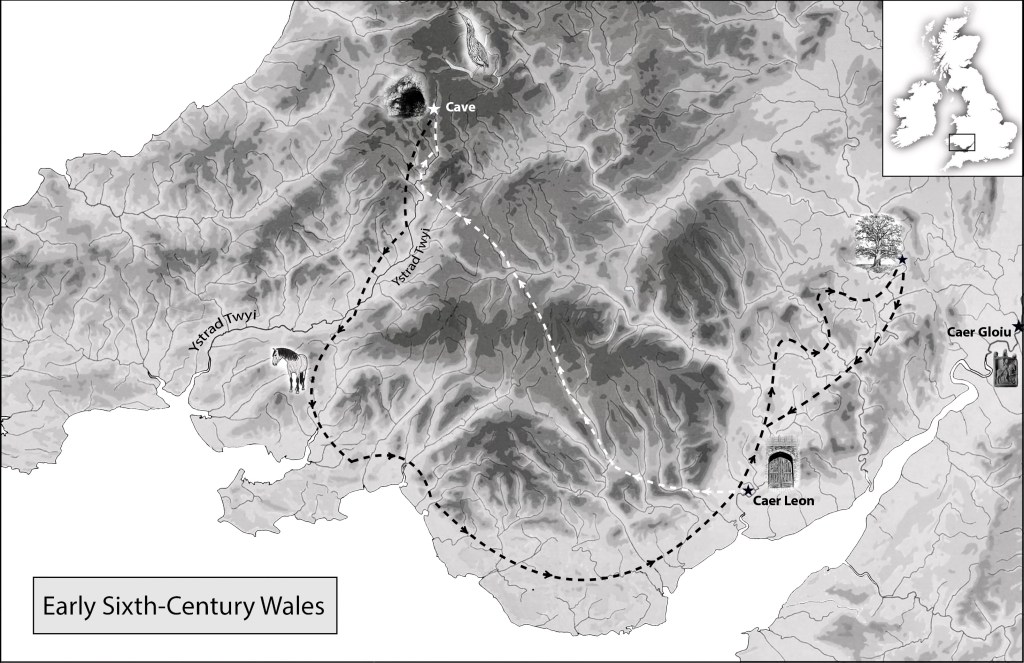I can’t believe I forgot to post about this! In April I published Spear, set in early sixth-century Wales. Actually, I forgot because I dithered so long over whether to post because, unlike Hild (and the forthcoming Menewood), Spear is a fantasy. I reconsidered after hearing from a handful of medievalists that they’re teaching the book.

When I say ‘fantasy’ I mean fantasy in the same sense that Mary Stewart’s The Crystal Cave is fantasy. That is, as novelists Stewart and I both paid attention to our contemporary historiography but did not feel bound by it.
Mary Stewart was writing not long after Arthur’s historicity was at its height—when most readers would still have been quite convinced of Arthur’s historical reality but medieval specialists were once again beginning to shake their heads. I, on the other hand, am writing at a time when almost all specialists would agree we can say nothing of any worth about the existence or not of Arthur or an Arthur-like figure. Of course, having said that, there are philologists out there (such as Andrew Breeze) who positively delight in tossing spanners in the works.1
The Matter of Britain is a national origin story and as such is problematic (to put it kindly; I wrote a short piece, History, Historicity, and Historiography in Arthurian Legend, about this for Historia2). So unlike Stewart, my focus is not on Merlin, or Arthur, or any other straight white nondisabled Master of the Universe. Here’s how I describe the book on my personal blog:
Spear is set in sixth-century Britain: early-medieval, like Hild, but with magic—not only the wild magic of the landscape, and of love and the human heart, but also the sword-swinging, monster-killing magic of myth and demigods. Instead of the Conversion Age, though, this is the Matter of Britain, but Arthur/Arturus does not live in castle, Merlin/Myrddyn is not a Good Guy, Nimuë is most definitely not a femme fatale, Guinevere/Gwenhwyfar is steely rather than an ingenue, and Percival/Peretur… Well, Peretur is definitely not the Peretur we think we know—not even the Peretur Peretur thought she knew.
Think of Spear as Hild let off the leash, unbound by those pesky historical constraints—and set a hundred years earlier, in Wales rather than England. The setting is throughly Celtic-flavoured, and so is the language: I aimed for prose that’s rhythmic and rippling and periphrastic. Arturus’s Companions (the Warriors Formerly Know As Knights of the Round Table) are much more various than the myth, the grail is very much not what it seems, and Caer Leon/Camelot is queered six ways from Sunday. In many ways, though, all that is peripheral. What takes centre stage is the journey of Peretur, a girl and then young woman who leaves home to find out who she is. Climate change and other real-world events are there as underpinnings—you won’t notice unless you’re looking—but essentially this is a Hero’s Journey, or, more accurately, a Heroine’s3 Real Hero’s Journey. All Heroes set out to win, and Peretur is no exception, but winning for her is not just about the slaying of monsters, human and otherwise—which she most definitely does, and with great élan—but about connecting: finding her people and a place to belong.
On my other site there are all sorts of nifty Spear-related things, like this map:

Image description: Black and white map of early sixth-century Wales. Inset in the top right corner is an outline of Britain, with a section of south and west Wales boxed in black. The rest of the map is an expansion of that box, a relief map showing hills, valleys, and rivers. There are several places labelled, and each place is represented by a small black and white drawing: a cave, a horse, a bittern, a tree, a fortified gate. Two sets of dotted lines with arrows indicate travel routes.
- For the map—I love making maps—I made some line drawings of animals such as a bittern, and Peretur’s horse Bony (which is actually a repurposed drawing of Hild’s horse, Flyte, from Menewood, only because— Ah, never mind. Go read the post).
- A PDF of the extensive Author’s Note, concerning the Arthurian character I call Peretur
- Animated illustrations with snippets of the audiobook, narrated by yours truly
- A whole post about recording the audiobook, Part One and Part Two
- Links to some useful interviews and reviews—I chose one’s with interesting and in-depth considerations of various aspects of the book
- A juicy post all about the book as physical object—it really is gorgeous
There’s also the main Spear page that I try to remember to update when/if there’s something new to report.
If you’re planning to teach the book and would like me to address something specific, please leave a comment here, or email me via the contact form. I love talking about my work to readers, students, teachers, critics, and academics of all stripes, so don’t be shy!
1 See, for example, Andrew Breeze (2015) THE HISTORICAL ARTHUR AND SIXTH-CENTURY SCOTLAND, Northern History, 52:2, 158-181, DOI: 10.1179/0078172X15Z.00000000085
2 It’s necessarily superficial, given the editorial brief, but, eh, even ten thousand words—a hundred thousand words—would not have been be enough!
3 I am not a fan of gendered diminutives: Peretur’s not a Heroine, Nimuë’s not a Sorceress, and I most definitely am not an Authoress.
I am Andrew Breeze, and had not through of myself as a spanner-tosser, but it is a fair description and I am rather flattered by it.
Andrew, good! I’m glad you’re flattered. I meant it that way—I love reading your work!